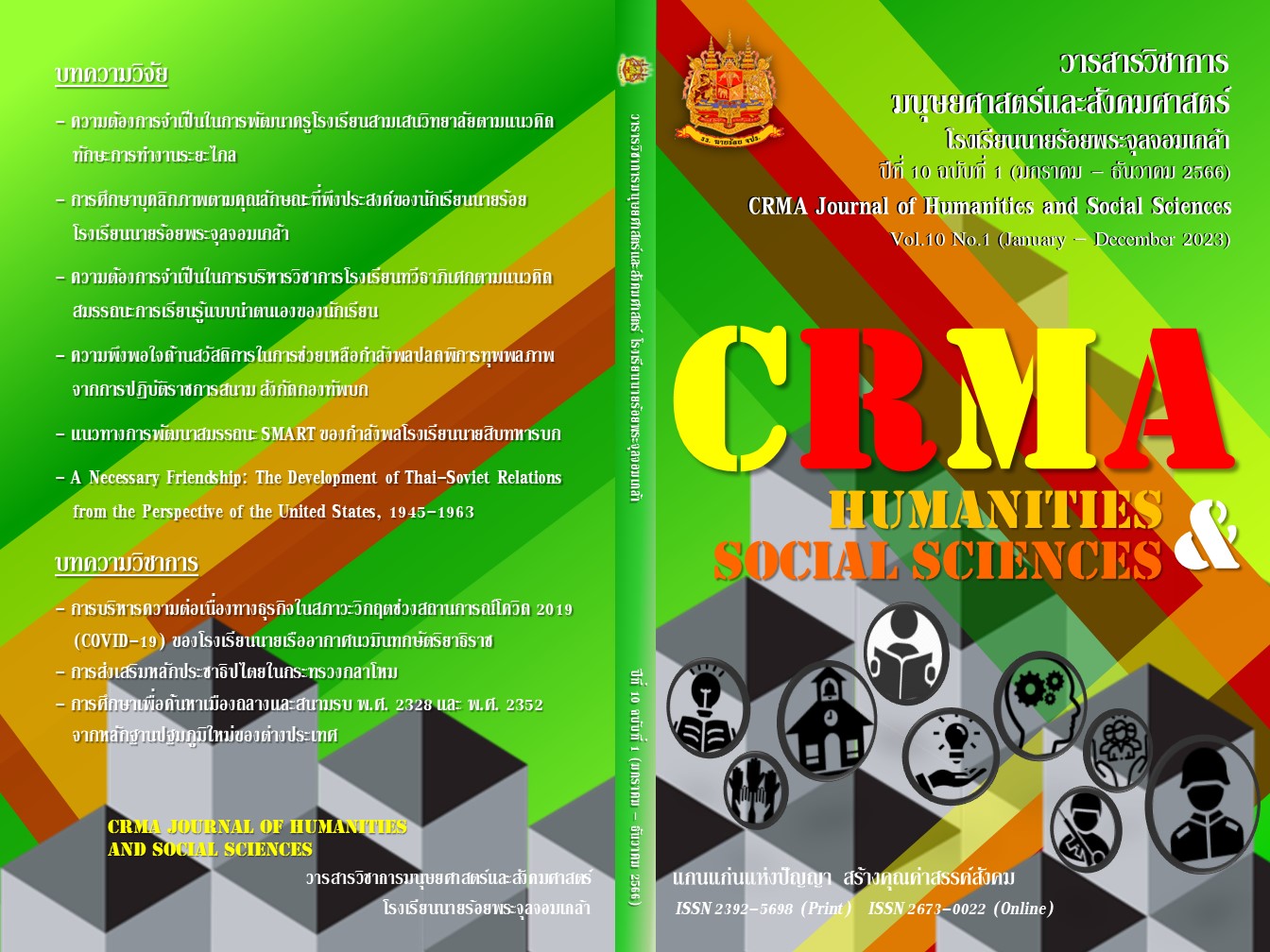แนวทางการพัฒนาสมรรถนะ SMART ของกำลังพลโรงเรียนนายสิบทหารบก
คำสำคัญ:
สมรรถนะหลัก , สมรรถนะ SMART , โรงเรียนนายสิบทหารบกบทคัดย่อ
บทความนี้มีวัตถุประสงค์เพื่อ 1) ศึกษาลักษณะส่วนบุคคลที่มีความสัมพันธ์กับสมรรถนะ SMART ของกำลังพลโรงเรียนนายสิบทหารบก 2) ศึกษาความสัมพันธ์เชิงเหตุ-ผลระหว่างสมรรถนะหลักกับสมรรถนะ SMART ของกำลังพลโรงเรียนนายสิบทหารบก 3) นำเสนอแนวทางการพัฒนาสมรรถนะ SMART ของกำลังพลโรงเรียนนายสิบทหารบก วิธีดำเนินการวิจัยเป็นการวิจัยแบบผสานวิธี โดยการวิจัยเชิงปริมาณเป็นหลักและตามด้วยการวิจัยเชิงคุณภาพ เก็บรวบรวมข้อมูลโดยใช้แบบสอบถาม กลุ่มตัวอย่างที่ใช้ คือ ข้าราชการทหารที่ปฏิบัติงานในโรงเรียนนายสิบทหารบก จำนวน 130 คน ได้มาโดยการสุ่มแบบชั้นภูมิ สถิติที่ใช้ในการวิเคราะห์ข้อมูล ได้แก่ ค่าร้อยละ ค่าเฉลี่ย ค่าเบี่ยงเบนมาตรฐาน ไคสแควร์ และการถดถอยพหุคูณ สำหรับการวิจัยเชิงคุณภาพใช้การสัมภาษณ์เชิงลึก จากผู้ให้ข้อมูลสำคัญโดยเลือกแบบเฉพาะเจาะจง คือ ผู้บังคับบัญชาในโรงเรียนนายสิบทหารบก จำนวน 8 คน โดยใช้การวิเคราะห์เนื้อหาเป็นแนวทางในการวิเคราะห์
ผลการวิจัยพบว่า 1) ลักษณะส่วนบุคคล คือ อายุและเวลารับราชการ มีความสัมพันธ์กับสมรรถนะ SMART ของกำลังพลโรงเรียนนายสิบทหารบก อย่างมีนัยสำคัญทางสถิติที่ระดับ 0.01 2) สมรรถนะหลักด้านความรู้ ลักษณะนิสัย แรงจูงใจ และทัศนคติมีความสัมพันธ์เชิงเหตุ-ผลกับสมรรถนะ SMART ในการปฏิบัติงานของกำลังพลโรงเรียนนายสิบทหารบก อย่างมีนัยสำคัญทางสถิติที่ระดับ 0.001 3) แนวทางการพัฒนาสมรรถนะ SMART ของกำลังพลโรงเรียนนายสิบทหารบก พบว่า โรงเรียนนายสิบทหารบกควรพัฒนาและส่งเสริมกำลังพลอย่างต่อเนื่องในด้านความเสียสละ ด้านมีคุณธรรม ด้านดำรงความถูกต้องพร้อมรับผิด ด้านมุ่งมั่นในผลสัมฤทธิ์ และด้านร่วมคิดทำงานเป็นทีม เพื่อให้สมรรถนะ SMART ของกำลังพลอยู่ในระดับสูงต่อไป
References
ดิสพงศ์ จันทร์นิล. (2561). การพัฒนาสมรรถนะการปฏิบัติงานของข้าราชการทหาร สังกัดกองพันทหารราบที่ 2 กรมทหารราบที่ 1 กองพลนาวิกโยธิน หน่วยบัญชาการนาวิกโยธิน [วิทยานิพนธ์ปริญญามหาบัณฑิต ไม่ได้ตีพิมพ์]. มหาวิทยาลัยนานาชาติแสตมฟอร์ด.
ธนะชัย เขียวจันทึก. (2565). ปัจจัยที่ส่งผลต่อการตัดสินใจศึกษาต่อในระดับปริญญาตรีของนักเรียนนายสิบทหารบก [วิทยานิพนธ์ปริญญามหาบัณฑิต ไม่ได้ตีพิมพ์]. มหาวิทยาลัยรามคำแหง.
ธวัช เนียมสิน. (2560). การพัฒนาสมรรถนะในการปฏิบัติงานของข้าราชการตำรวจในสังกัดตำรวจภูธร จังหวัดเพชรบุรี [วิทยานิพนธ์ปริญญามหาบัณฑิต ไม่ได้ตีพิมพ์]. มหาวิทยาลัยนานาชาติแสตมฟอร์ด.
ธวัชชัย ผลสะอาด. (2559). กำลังพลสำรองกองร้อยที่ 1 กองพันทหารราบที่ 2 รักษาพระองค์ค่ายพรหมโยธิน อำเภอเมือง จังหวัดปราจีนบุรี: กรณีศึกษาเปรียบเทียบระบบการเกณฑ์ทหารและการรับราชการทหารโดยสมัครใจ [การค้นคว้าอิสระปริญญามหาบัณฑิต ไม่ได้ตีพิมพ์]. มหาวิทยาลัยธรรมศาสตร์.
นักศึกษาหลักสูตรหลักประจำวิทยาลัยการทัพบก ชุดที่ 61. (2559). ยุทธศาสตร์กองทัพบก 20 ปี พ.ศ. 2560-2579. อรุณการพิมพ์.
พงศธร เมืองแก่น. (2562). นักรบที่สง่างามนำพากองทัพเข้มแข็ง (SMART SOLDIERS STRONG ARMY). [สารนิพนธ์ปริญญามหาบัณฑิต ไม่ได้ตีพิมพ์]. วิทยาลัยการทัพบก.
ภาณุพงศ์ สุวัณณุสส์. (2551). ตัวแบบสมรรถนะหลักของผู้สำเร็จการศึกษาจากหลักสูตรหลักประจำโรงเรียนเสนาธิการทหารบก[วิทยานิพนธ์ปริญญามหาบัณฑิต ไม่ได้ตีพิมพ์]. มหาวิทยาลัยราชภัฏสวนดุสิต.
ภาณุมาศ เวหาด. (2559). สมรรถนะหลักกับประสิทธิผลในการปฏิบัติงานด้านงานข่าวของข้าราชการทหาร สังกัดกอง 6 ศูนย์รักษาความปลอดภัย กองบัญชาการกองทัพไทย. [สารนิพนธ์ปริญญามหาบัณฑิต ไม่ได้ตีพิมพ์]. มหาวิทยาลัยเกริก.
มานัสชัย ศรีประจันทร์. (2561). แนวทางการพัฒนาสมรรถนะกำลังพลกองทัพบก. วิทยาลัยป้องกันราชอาณาจักร.
ศุภชัย หวั่นวดี. (2563). แนวทางการพัฒนาสมรรถนะ SMART ของกำลังพลในกองบิน 5 กองทัพอากาศ ในยุค 4.0. [วิทยานิพนธ์ปริญญามหาบัณฑิต ไม่ได้ตีพิมพ์]. มหาวิทยาลัยนานาชาติแสตมฟอร์ด.
สำนักงานคณะกรรมการพัฒนาระบบราชการ. (2556). คู่มือการกำหนดสมรรถนะในราชการพลเรือน: คู่มือสมรรถนะหลัก. สำนักงานคณะกรรมการข้าราชการพลเรือน.
Green, S.B. (1991). How many subjects does it take to do a regression analysis?. Multivariate Behavioural Research, 26(3), 499-510.
McClelland, D.C. (1973). Testing for competence rather than intelligence. American Psychologist, 28(1), 1-14.
McClelland, D.C. (1998). Identifying competencies with behavioral event interviews. Psychological Science, 9(5), 331-339.
Downloads
เผยแพร่แล้ว
How to Cite
ฉบับ
บท
หมวดหมู่
License
Copyright (c) 2023 วารสารวิชาการมนุษยศาสตร์และสังคมศาสตร์ โรงเรียนนายร้อยพระจุลจอมเกล้า

This work is licensed under a Creative Commons Attribution-NonCommercial-NoDerivatives 4.0 International License.
เนื้อหาและข้อมูลที่ตีพิมพ์ในวารสารนี้ถือเป็นข้อคิดเห็นและความรับผิดชอบของผู้เขียนบทความโดยตรงกองบรรณาธิการวารสารไม่จำเป็นต้องเห็นด้วยหรือร่วมรับผิดชอบในทุกกรณี
บทความและข้อมูลที่ได้รับการตีพิมพ์ในวารสารนี้ถือเป็นลิขสิทธิ์ของวารสารผู้ใดต้องการตีพิมพ์ซ้ำต้องได้รับอนุญาตจากบรรณาธิการวารสารก่อนเท่านั้น และบทความที่ได้รับการตอบรับเพื่อตีพิมพ์ในวารสารนี้จะต้องไม่ปรากฎในสิ่งพิมพ์อื่นใดมาก่อนที่จะปรากฎในวารสารนี้ กองบรรณาธิการจะส่งวารสารที่มีบทความของผู้เขียนตีพิมพ์ให้แก่ผู้เขียนจำนวน 1 ฉบับ






